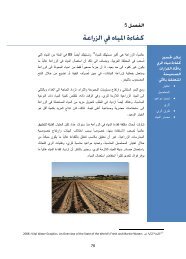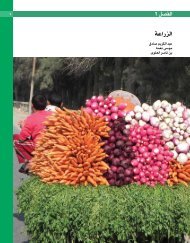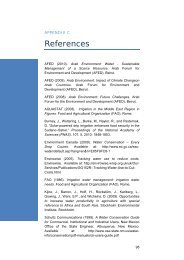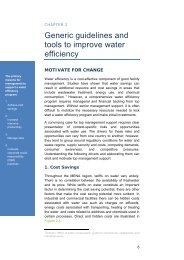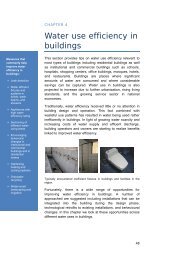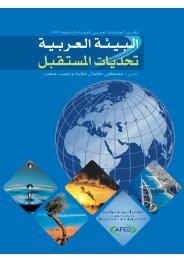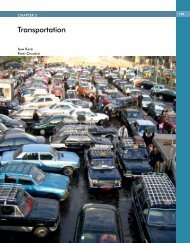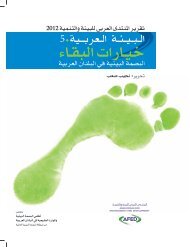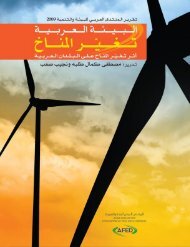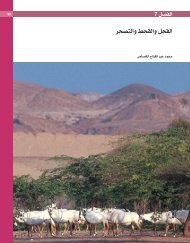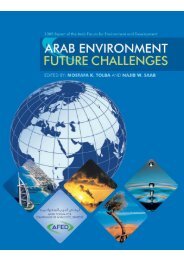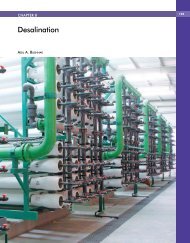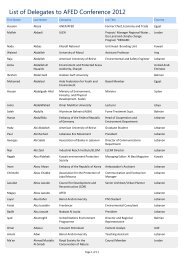Impact of Climate Change on Arab Countries - (IPCC) - Working ...
Impact of Climate Change on Arab Countries - (IPCC) - Working ...
Impact of Climate Change on Arab Countries - (IPCC) - Working ...
You also want an ePaper? Increase the reach of your titles
YUMPU automatically turns print PDFs into web optimized ePapers that Google loves.
ARAB ENVIRONMENT: CLIMATE CHANGE 127<br />
has estimated the cost <str<strong>on</strong>g>of</str<strong>on</strong>g> envir<strong>on</strong>mental degradati<strong>on</strong><br />
in coastal z<strong>on</strong>es <str<strong>on</strong>g>of</str<strong>on</strong>g> four <strong>Arab</strong> countries,<br />
Algeria, Egypt, Morocco and Tunisia. In making<br />
the calculati<strong>on</strong>s, the local GDP per pers<strong>on</strong> at the<br />
local level was c<strong>on</strong>sidered equivalent to the<br />
nati<strong>on</strong>al average. This study c<strong>on</strong>cluded that the<br />
total annual cost related to envir<strong>on</strong>mental damage<br />
<str<strong>on</strong>g>of</str<strong>on</strong>g> a coastal z<strong>on</strong>e in Egypt (Alexandria bay) is<br />
around $232-355 milli<strong>on</strong>, which is 5.0 to 7.5%<br />
<str<strong>on</strong>g>of</str<strong>on</strong>g> the total GDP <str<strong>on</strong>g>of</str<strong>on</strong>g> the study area; in Morocco,<br />
it was estimated to be $14-18 milli<strong>on</strong>, which is<br />
3.7-4.7% <str<strong>on</strong>g>of</str<strong>on</strong>g> GDP in the regi<strong>on</strong> where the study<br />
was c<strong>on</strong>ducted (Lago<strong>on</strong> <str<strong>on</strong>g>of</str<strong>on</strong>g> Nador area); in<br />
Algeria it was found to be $22-53 milli<strong>on</strong>, which<br />
amounts to 3 to 7% <str<strong>on</strong>g>of</str<strong>on</strong>g> the GDP <str<strong>on</strong>g>of</str<strong>on</strong>g> the Algiers<br />
bay; and in Tunisia it was assessed to be $38-72<br />
milli<strong>on</strong>, or 1.3-2.3% <str<strong>on</strong>g>of</str<strong>on</strong>g> the GDP <str<strong>on</strong>g>of</str<strong>on</strong>g> the Soussa<br />
regi<strong>on</strong>. Some <str<strong>on</strong>g>of</str<strong>on</strong>g> these costs were attributed to a<br />
loss in tourism activity resulting from envir<strong>on</strong>mental<br />
degradati<strong>on</strong>.<br />
Some plant flora and fauna species <str<strong>on</strong>g>of</str<strong>on</strong>g> the <strong>Arab</strong><br />
world may not be able to adapt to the accelerating<br />
rate <str<strong>on</strong>g>of</str<strong>on</strong>g> climate change which is exacerbated<br />
by the changes induced in ecosystems by the<br />
over-harvesting <str<strong>on</strong>g>of</str<strong>on</strong>g> natural resources or by various<br />
types <str<strong>on</strong>g>of</str<strong>on</strong>g> polluti<strong>on</strong>. Some species might resp<strong>on</strong>d<br />
by migrating either in latitude or in altitude, but<br />
some might be c<strong>on</strong>demned to extincti<strong>on</strong>.<br />
It is known that a change <str<strong>on</strong>g>of</str<strong>on</strong>g> the average temperature<br />
by <strong>on</strong>ly <strong>on</strong>e degree will imply a radical disturbance<br />
<str<strong>on</strong>g>of</str<strong>on</strong>g> natural ecosystems. This will be due<br />
not <strong>on</strong>ly to the direct effect <str<strong>on</strong>g>of</str<strong>on</strong>g> temperature<br />
increase but also to the hydrous stress and other<br />
phenomena which may result from this temperature<br />
variati<strong>on</strong> such as forest fires and intensive<br />
evapotranspirati<strong>on</strong> (<strong>IPCC</strong>, 2007). The integrity<br />
<str<strong>on</strong>g>of</str<strong>on</strong>g> all types <str<strong>on</strong>g>of</str<strong>on</strong>g> biodiversity (genes, species, ecosystems<br />
and landscapes) will be impacted significantly,<br />
potentially even leading to chaotic situati<strong>on</strong>s.<br />
The ecotourism and in fact any tourism<br />
based <strong>on</strong> the natural envir<strong>on</strong>ment in the <strong>Arab</strong><br />
world will therefore be affected by climate<br />
changes.<br />
Tourism and local products<br />
A number <str<strong>on</strong>g>of</str<strong>on</strong>g> tourism activities in <strong>Arab</strong> countries<br />
are dependent <strong>on</strong> local products derived from the<br />
exploitati<strong>on</strong> <str<strong>on</strong>g>of</str<strong>on</strong>g> natural resources. <str<strong>on</strong>g>Climate</str<strong>on</strong>g> change<br />
can, bey<strong>on</strong>d a certain threshold, lead to the rarefacti<strong>on</strong><br />
<str<strong>on</strong>g>of</str<strong>on</strong>g> these resources, and might lead to<br />
changes <str<strong>on</strong>g>of</str<strong>on</strong>g> local and indigenous practices for the<br />
producti<strong>on</strong> <str<strong>on</strong>g>of</str<strong>on</strong>g> local goods.<br />
V. ADAPTATION TO CLIMATE CHANGE<br />
To date, there are <strong>on</strong>ly a few exploratory studies<br />
related to the relati<strong>on</strong>ship between tourism in the<br />
<strong>Arab</strong> world and the potential impacts <str<strong>on</strong>g>of</str<strong>on</strong>g> climate<br />
change. Research initiatives remain limited and it<br />
is necessary to better prepare this ec<strong>on</strong>omic sector<br />
to face the challenges <str<strong>on</strong>g>of</str<strong>on</strong>g> climate change.<br />
There is the need to address many essential<br />
points which encompass a deep knowledge <str<strong>on</strong>g>of</str<strong>on</strong>g><br />
tourism requirements and needs for climate and<br />
envir<strong>on</strong>ment, and weather c<strong>on</strong>diti<strong>on</strong>s; how different<br />
tourism products and services are sensitive<br />
and vulnerable to climate change; and a mapping<br />
<str<strong>on</strong>g>of</str<strong>on</strong>g> potential risks and threats with respect to climate<br />
change scenarios in different regi<strong>on</strong>s <str<strong>on</strong>g>of</str<strong>on</strong>g> the<br />
<strong>Arab</strong> world. This last point includes downscaling<br />
<str<strong>on</strong>g>of</str<strong>on</strong>g> <strong>IPCC</strong> scenarios, vulnerability assessment and<br />
adaptati<strong>on</strong> opti<strong>on</strong>s.<br />
VI. CONCLUSION<br />
The <strong>Arab</strong> world’s tourism sector is closely related<br />
to the landscape, envir<strong>on</strong>mental and cultural<br />
characteristics <str<strong>on</strong>g>of</str<strong>on</strong>g> the area and is by its nature<br />
str<strong>on</strong>gly sensitive to the variability and change <str<strong>on</strong>g>of</str<strong>on</strong>g><br />
the climate, either directly or indirectly.<br />
Destinati<strong>on</strong>s and preferences might be influenced<br />
by potential modificati<strong>on</strong>s from the normal<br />
c<strong>on</strong>diti<strong>on</strong>s (hotter summers and winters,<br />
droughts, dryness and droughts, extreme weather<br />
events, scarcity <str<strong>on</strong>g>of</str<strong>on</strong>g> water, ecosystems degradati<strong>on</strong>,<br />
etc.). The potential disturbances <str<strong>on</strong>g>of</str<strong>on</strong>g> tourism flows<br />
and destinati<strong>on</strong>s will result in large ec<strong>on</strong>omic<br />
losses, primarily for countries whose ec<strong>on</strong>omies<br />
are tourism-based. It must be noted that the<br />
exact trajectory <str<strong>on</strong>g>of</str<strong>on</strong>g> the changes and impacts is<br />
related to large uncertainties about tourists’<br />
behaviour. Serious efforts should be expended in<br />
order to identify other sustainable means <str<strong>on</strong>g>of</str<strong>on</strong>g><br />
tourism which might be less sensitive to climate<br />
change and its effects such as cultural tourism.<br />
The capacities for adaptati<strong>on</strong> <str<strong>on</strong>g>of</str<strong>on</strong>g> tourism destinati<strong>on</strong>s<br />
and actors will be highly variable (Cer<strong>on</strong><br />
and Dubois, 2008) from <strong>on</strong>e area to another and<br />
integrated and inclusive planning is a must for<br />
enhancing the chances <str<strong>on</strong>g>of</str<strong>on</strong>g> success for any course<br />
future tourism development might follow.



